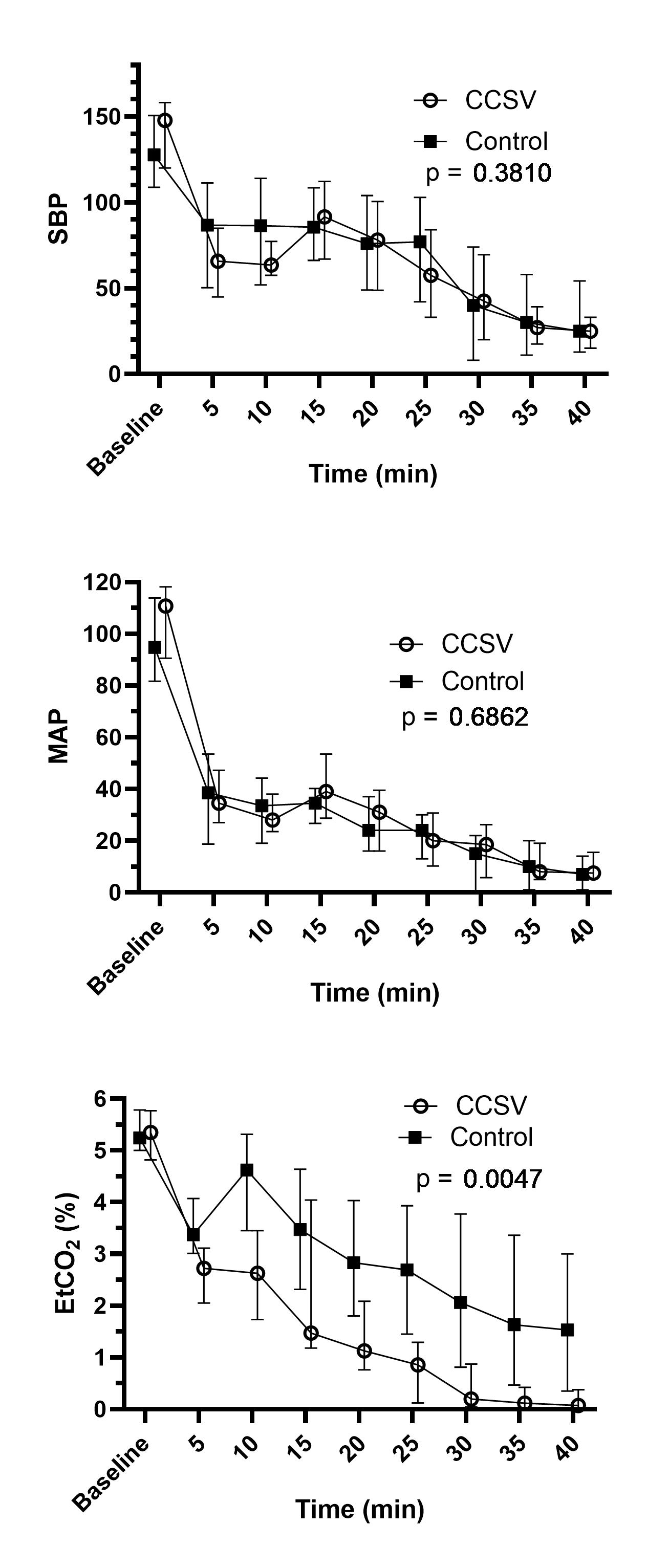Final ID: Sa1004
Chest compression synchronized ventilation is associated with improved oxygenation but also with increased incidence of pneumothoraces in an experimental CPR model.
Abstract Body: Background
Recent experimental results have shown promising potential for chest compression synchronized ventilation (CCSV). This technique triggers ventilation during cardiopulmonary resuscitation (CPR) by the counterpressure from each chest compression (f = 100 min-1), with a positive inspiratory pressure of 60 mbar. The objective is to enhance the compressive force directed at the heart and increase venous return while preventing lung atelectasis.
We examined the effects of CCSV on arterial blood gas levels, pH and lactate compared to manual ventilation in an animal model of CPR. The hypothesis was, that it would provide superior oxygenation sustained over 30 minutes of advanced life support (ALS).
Methods
Anesthetized healthy Landrace pigs (n = 30; weight circa 50 kg) were electrically induced to ventricular fibrillation and randomized to either CCSV (delivered with the Medumat standard2 ventilator) or conventional ventilation (manual bag-valve) with mechanical chest compressions by LucasTM 2.
After a 5 min no-flow time ALS was commenced and delivered for 35 minutes. The pigs were not defibrillated but received three 1 mg intravenous doses of epinephrine. Arterial blood gas samples were taken in 5 min intervals. Femoral artery pressure levels and end-tidal carbon dioxide (EtCO2) were measured continuously. PaO2, PaCO2, pH, lactate, arterial pressures and EtCO2 over time were compared using a mixed linear model. Chest injuries were diagnosed with post-mortem CT scans.
Results
PaO2 levels were significantly higher in the CCSV group (p = 0.0455, Figure 1). EtCO2 levels were significantly lower in the CCSV group (p = 0.0047) whereas there was no difference in SBP or MAP (Figure 2). The number of pneumothoraxes were significantly higher in the CCSV group (12 vs. 3, p = 0.0078) with 8 being severe.
Conclusions
CCSV provides increased oxygenation but is associated with more pneumothoraces in this animal model. The effect on hemodynamics was neutral. The promising CCSV protocol warrants further research and refinement.
Recent experimental results have shown promising potential for chest compression synchronized ventilation (CCSV). This technique triggers ventilation during cardiopulmonary resuscitation (CPR) by the counterpressure from each chest compression (f = 100 min-1), with a positive inspiratory pressure of 60 mbar. The objective is to enhance the compressive force directed at the heart and increase venous return while preventing lung atelectasis.
We examined the effects of CCSV on arterial blood gas levels, pH and lactate compared to manual ventilation in an animal model of CPR. The hypothesis was, that it would provide superior oxygenation sustained over 30 minutes of advanced life support (ALS).
Methods
Anesthetized healthy Landrace pigs (n = 30; weight circa 50 kg) were electrically induced to ventricular fibrillation and randomized to either CCSV (delivered with the Medumat standard2 ventilator) or conventional ventilation (manual bag-valve) with mechanical chest compressions by LucasTM 2.
After a 5 min no-flow time ALS was commenced and delivered for 35 minutes. The pigs were not defibrillated but received three 1 mg intravenous doses of epinephrine. Arterial blood gas samples were taken in 5 min intervals. Femoral artery pressure levels and end-tidal carbon dioxide (EtCO2) were measured continuously. PaO2, PaCO2, pH, lactate, arterial pressures and EtCO2 over time were compared using a mixed linear model. Chest injuries were diagnosed with post-mortem CT scans.
Results
PaO2 levels were significantly higher in the CCSV group (p = 0.0455, Figure 1). EtCO2 levels were significantly lower in the CCSV group (p = 0.0047) whereas there was no difference in SBP or MAP (Figure 2). The number of pneumothoraxes were significantly higher in the CCSV group (12 vs. 3, p = 0.0078) with 8 being severe.
Conclusions
CCSV provides increased oxygenation but is associated with more pneumothoraces in this animal model. The effect on hemodynamics was neutral. The promising CCSV protocol warrants further research and refinement.
More abstracts on this topic:
Association between dynamic cerebral perfusion indices by NIRS and cerebral microvascular flow during CPR in a porcine cardiac arrest model
Kiguchi Takeyuki, Nishioka Norihiro, Kamo Wataru, Ninomiya Kouhei, Makino Yuto, Kamada Tsuyoshi, Maeda Hideki, Iwami Taku
A Multicentre Study for Hands Only CPR (HOCPR) training assessment towards building a ‘Nation of Life Savers” in IndiaRavikumar Thanjavur, Sarma Kvs, Ravikumar Thanjavur, Sarkar Manuj, Debnath Dhrubajyoti, Behera Priyamadhaba, Ghate Jayshri, Trikha Divay, Samantaray A, Madhavi K


